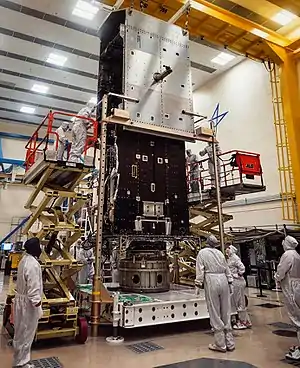GOES-T
GOES-T is the third of the "GOES-R Series", the actual generation of weather satellites operated by the National Oceanic and Atmospheric Administration (NOAA), giving sequence to the GOES system. The current and next satellites of the Series (GOES-16, GOES-17, GOES-T, and GOES-U) will extend the availability of the Geostationary Operational Environmental Satellite (GOES) satellite system until 2037. The satellite will be built by Lockheed Martin in Littleton, Colorado. It will be based on the A2100A platform and will have an expected useful life of 15 years (10 operational after five years in orbit replacement).[1]
 The 'Brains' and 'Body' of the GOES-T Satellite are merged. | |
| Names | GOES-18 |
|---|---|
| Mission type | Earth weather forecasting |
| Operator | NOAA / NASA |
| Mission duration | 15 years (planned) |
| Spacecraft properties | |
| Spacecraft type | GOES-R Series |
| Bus | Lockheed Martin A2100 |
| Manufacturer | Lockheed Martin |
| Launch mass | 2,800 kg (6,200 lb) |
| Start of mission | |
| Launch date | December 2021 (planned) |
| Rocket | Atlas V |
| Launch site | CCSFS, SLC-41 |
| Contractor | United Launch Alliance (ULA) |
| Entered service | 2022 (planned) |
| Orbital parameters | |
| Reference system | Geocentric orbit |
| Regime | Geostationary orbit |
Benefits and applications
- Improved hurricane track and intensity forecasts
- Increased thunderstorm and tornado warning lead time
- Earlier warning of lightning ground strike hazards
- Better detection of heavy rainfall and flash flood risks
- Better monitoring of smoke and dust
- Improved air quality warnings and alerts
- Better fire detection and intensity estimation
- Improved detection of low cloud / fog
- Improved transportation safety and aviation route planning
- Improved warning for communications and navigation disruptions and power blackouts
- More accurate monitoring of energetic particles responsible for radiation hazards
The GOES-R Series also continues the legacy Geostationary SAR (GEOSAR) function of the SARSAT system onboard NOAA's GOES satellites which has contributed to the rescue of thousands of individuals in distress. The GOES-R Series SARSAT transponder operates with a lower uplink power than the previous system, enabling GOES-R Series satellites to detect weaker beacon signals.
Redesign
In May 2018, NOAA announced that the recently launched GOES-17 satellite was suffering from a severe malfunction in its instrument cooling system which resulted in degraded performance of its infrared sensors. The cause of the problem was determined to be with the loop heat pipe (LHP), which transports heat from the Advanced Baseline Imager (ABI) to a radiator for rejection into space. Since the LHP design was shared among all four GOES-R Series satellites, a redesign was required to prevent the anomaly from happening again on GOES-T and GOES-U. Lockheed Martin had already completed assembly of GOES-T and had to remove the ABI instrument in October 2018 and ship it to its manufacturer, Harris Corporation, to be rebuilt.[2][nb 1]
Launch
The satellite was originally planned to launch in May 2020 from Cape Canaveral Air Force Station (CCAFS), Florida, United States.[3] Because of the repairs to correct the loop heat pipe problem, the deployment of GOES-T was be delayed. As of January 2021, the launch date is scheduled for December 2021.[1]
GOES-T is planned to have a mass of 2,800 kg.[4]
Notes
- The LHP was actually manufactured by Orbital ATK, which is now a part of Northrop Grumman, while the ABI was built by Exelis Inc., now a part of Harris Corp.
References
- "Mission overview". NOAA. January 2021. Retrieved 20 January 2021.
 This article incorporates text from this source, which is in the public domain.
This article incorporates text from this source, which is in the public domain. - "Lockheed Martin halts work on GOES-T to wait for instrument fix". SpaceNews. 9 January 2019. Retrieved 26 May 2019.
- Oswald, Ed (22 November 2016). "Launch of GOES-R satellite a game-changing moment for weather forecasting". Digital Trends. Retrieved 29 November 2016.
- Ray, Justin (22 August 2016). "Sophisticated new U.S. weather observatory being readied for launch". Spaceflight Now. Retrieved 19 October 2016.
